CIA Drone Strikes and the Public Authority Justification
Published by The Lawfare Institute
in Cooperation With

In a pair of posts (here and here), Kevin Heller at Opinio Juris explores a very interesting question: What exactly is the domestic legal foundation for the CIA’s use of lethal force given that the 2001 AUMF refers explicitly to US armed forces only? As he points out, the question matters especially in connection with the drone strike that killed US citizen Anwar al-Aulaqi, since 18 USC 1119 criminalizes the killing of US citizens abroad, and CIA officials could only avoid liability via the “public authority” justification if there is a proper domestic law justification.
Kevin highlights two possible sources of authority, and rejects them both as inapplicable. First, he rejects the 2001 AUMF on the ground that it refers explicitly, and only, to the use of US armed forces. Second, he rejects the argument that Title 50’s covert action provisions can provide the justification, reasoning that drone strikes cannot be considered “covert action” within the statute’s meaning because they qualify, instead as “traditional military activity” (“TMA”)—a category that is excluded by statute from the definition of covert action.
I disagree with Kevin’s ultimate conclusion for several reasons.
CIA Drone Strikes Don’t Qualify as TMA: As an initial matter, I think one part of his argument depends on a mistaken assumption regarding the meaning of TMA, and that drone strikes do indeed constitute covert action within the meaning of Title 50. The TMA exception to covert action has a complicated and often-misunderstood history, which I recount in detail in this paper (pp.592-601 especially). The concept was the subject of extensive negotiations between the White House and Congress, ultimately resulting in the following agreement. An activity that otherwise would qualify as covert action would instead count as TMA, thus avoiding the requirement of a written presidential finding and reporting to SSCI and HPSCI, if the following conditions were met. the operation:
1) was commanded and executed by military personnel, and 2) took place in a context in which overt hostilities either were (a) ongoing, or (b) “anticipated (meaning approval has been given by the National Command Authorities for [i] the activities and for [ii] operational planning for hostilities).”The CIA drone strike program as a general matter almost certainly does not satisfy this test, especially the first prong. This is why it has been long considered by both the Bush and Obama administrations to be covert action, not TMA. If the covert-action statute is capable of conferring the benefits of the public-authority justification, then, it does so here. Covert Action Is Not the Only Option for CIA Under Title 50: Another point to bear in mind is that Title 50’s enumeration of CIA functions is not limited to covert action. It includes a sweeping authority to perform “other functions and duties related to intelligence,” generally known as the “fifth function.” This generic language for decades was the statutory foundation for covert action, of course, but it is not necessarily coextensive with the covert action category. By its terms, it could encompass CIA operational activity that for whatever reason did not qualify as covert action as later statutes have defined it. OK, fine, but aren't covert action programs bound to comply with federal statutes, including 1119? They sure are, and it is important to the continuing legitimacy of the covert-action instrument that it be subject to American law in this way. But the question remains: Does the covert drone strike program violate 1119 as applied to al-Aulaqi? Kevin argues that it does because the AUMF should be read to exclude CIA, and thus that section 1119 is violated, and thus that the requirement that covert action programs comply with statutes is violated too. I don't agree, however, for I don't think the AUMF is the only possible domestic law explanation for the CIA's role; Article II likely applies here as well, and performs the same function as the AUMF in this respect. True, some believe that the better view of the separation of powers is that the President should not be able to engage in airstrikes without explicit congressional authorization. If you take that view, or if you at least believe that any Article II authority the president has does not extend to the al-Aulaqi scenario, then Article II of course could not be the source of authority for the public-authority justification in this instance. The CIA may be in trouble in that case. But I am pretty sure that the Obama administration, like the Bush administration before it, has a much broader understanding of Article II; see Iraq this summer, as well as speeches from administration officials explaining their broad understanding of “imminent threat”(the standard that almost certainly would govern under an Article II self-defense analysis). If we change the al-Aulaqi fact pattern such that there was no AUMF at the time, but keep the premise that al-Aulaqi was involved in operational planning targeting Americans, I think we can be confident that the administration would have carried out the strike just as it did under the AUMF. I think that this, either alone or in combination with Title 50, is a persuasive explanation as to why the public-authority justification applies even if the CIA does not benefit directly from the AUMF. [Note: None of this analysis attempts to answer the distinct question whether al-Aulaqi received the procedural safeguards that were due, under the Fifth Amendment Due Process Clause, to an American citizen in this particular circumstance.]
Robert (Bobby) Chesney is the Dean of the University of Texas School of Law, where he also holds the James A. Baker III Chair in the Rule of Law and World Affairs at UT. He is known internationally for his scholarship relating both to cybersecurity and national security. He is a co-founder of Lawfare, the nation’s leading online source for analysis of national security legal issues, and he co-hosts the popular show The National Security Law Podcast.


e304b8c6-62ac-4691-8f59-0c9a301d1565.jpg?sfvrsn=2eb0521f_8)


